To access this section of the website you need to be registered
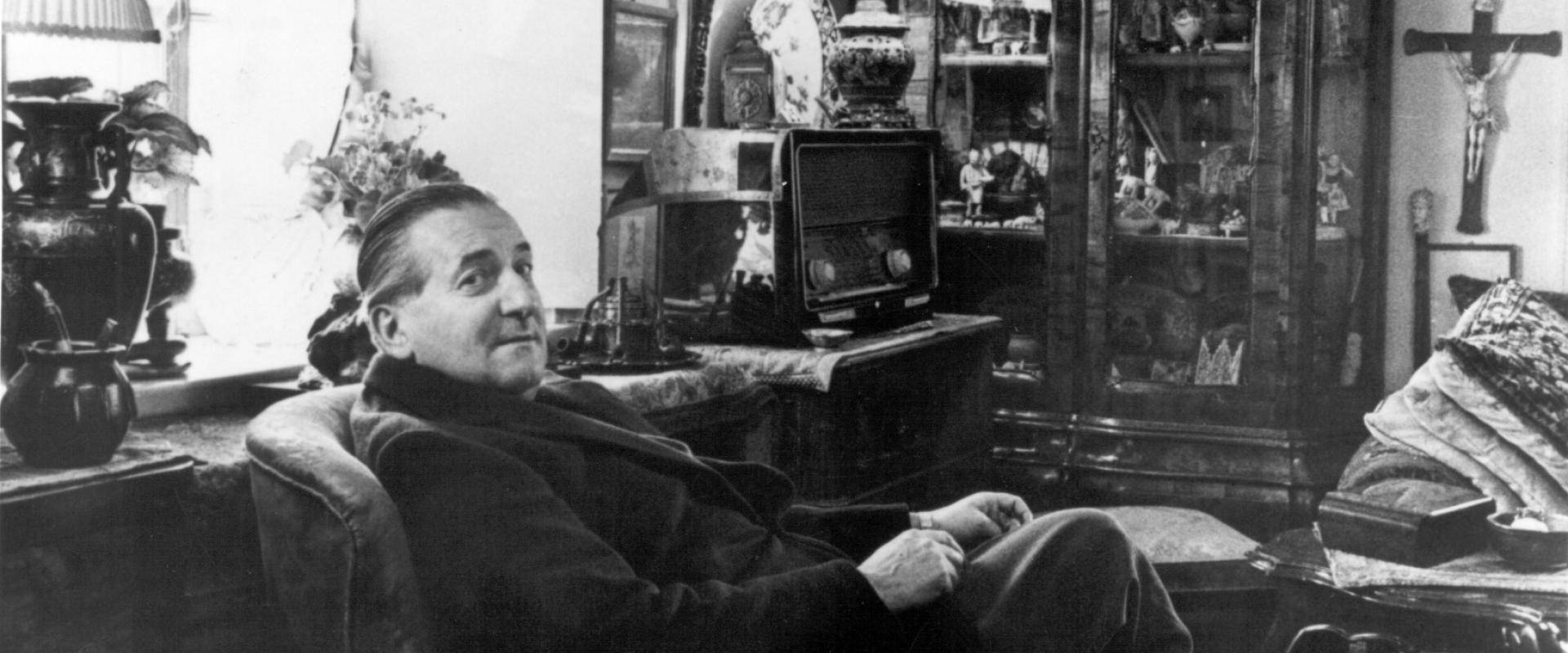
1900: Mario Rimoldi was born in Cortina d’Ampezzo on April 13 to Antonio Rimoldi and Sabina Caterina Zangiacomi.
1921: He attended the Hotel Management School in Rome where he started to frequent artistic circles. «He invests his savings in knick-knacks, decorative ornaments, some small bronze, some modest canvas» (Zangrando). At the time, he was mainly interested in eighteenth century art: Irolli, Morelli, Gigante, etc. (interview with Rimoldi by Paolo Rizzi).
1923: Rimoldi returned to Cortina and opened a tourist office (Garage Centrale) at Villa Esperia in Corso Italia with his brother Arturo and some other partners. He filled his office with paintings, despite the ironic comments of his fellow townspeople. He hired Miss Alma Apollonio as his secretary. She would work in the office with exemplary enthusiasm until Rimoldi’s death and would also take care of the collection.
1929: [Thanks to Giorgio Zamberlan] Rimoldi first met Filippo de Pisis (interview with Rimoldi by Paolo Rizzi) who had been spending his holiday in the Cadore valley since 1924.
1930: He already owned a considerable collection «the core of which consisted in the paintings of de Pisis, still enigmatic to the common eye» (Comisso, quoted by Sergio Beer). «From now on he will travel extensively to Milan, Rome and Paris to buy, select and keep updated» (Renato Giani).
1937: de Pisis sojourned at Hotel Corona (owned by Mario and Arturo Rimoldi). He painted the Church and the Bell-tower of Cortina (he would paint the same subject in the following years). Mario Rimoldi bought the painting for a thousand Lire, the highest sum he ever spent for a de Pisis painting.
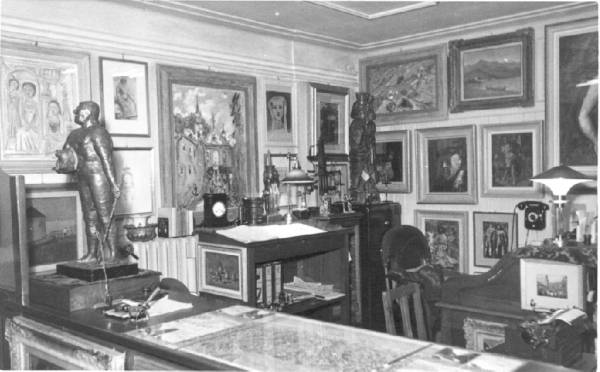
1938: Rimoldi and de Pisis became closer and closer. On 27th July Rimoldi sent the following letter to de Pisis, addressed to 7, Rue Servandoni in Paris: «I’m happy to inform you that I am the owner of as many as eleven marvellous DE PISIS paintings [...] I could have sold them many times and earned quite a lot of money! But I can’t seem to be able to do without them, at no cost. My collection consists of about 200 works now, including some excellent, some good, and some horrible pieces. Let me tell you that after so many years of experience in purchasing art works, I have finally taken a direction – the best direction – of choosing works by contemporary artists. I really appreciate the works of Soffici, de Chirico, Carrà, Ravenna, Mucchi, Tomea, etc. I own some works by Juti Ravenna, Da Venezia, Cancian, Mancini, Verni... The best works however are always those made by DE PISIS - for their pictorial quality and their proven sensibility, culture, and intelligence». To these words of enthusiastic devotion de Pisis replied from Château d'Argenteuil Fleurance (Gers), on August 2nd, 1938 as follows: «Dear Sir and Friend, I have received your beautiful letter which fills me with pleasure. I am glad to hear that my simple art gives you some joy. Here too I work, sometimes with pleasure, but at times with some distress. The landscape, although still interesting, is quite different from the Marmarole “dear to Vecellio” (Carducci). I will not be able to come to Cortina now because I have to go to Cannes and then to Venice, but I would like to spend a month there this winter. I have never painted ’snow’ and I could create something interesting».
1939: Minister of Education Bottai opened the “Mostra del paesaggio nazionale e bergamasco” exhibition at the Palazzo della Ragione in Bergamo, on September 10. The exhibition was organized by the Unione Provinciale Professionisti e Artisti. de Pisis painting La Chiesa di Cortina (The Church of Cortina, sent in by Mario Rimoldi) was awarded the second prize – a sum of 10,000 Lire. de Pisis referred to this important work when he wrote a letter to Rimoldi from Paris (7 Rue Servandoni), dated June 24, 1939: «Dear Friend, considering your kind interest in my paintings, let me ask you a favour, i.e: sending one of my landscapes that you own, namely La Chiesa di Cortina to Bergamo (Piazza Vecchia - Palazzo della Ragione) before August 15 for a contest». The tone of Rimoldi’s reply, dated June 27, is rather concerned and defensive: «I would not have too much difficulty in sending La Chiesa di Cortina – the most precious painting in my collection – to the municipality of Bergamo, at their expense. Before sending such an important work of yours, I will obviously write to the municipality of Bergamo to ensure that they guard this work with the greatest of care, as befits the amount of importance I attach to it, against fire, theft, or any other damage that might occur». When de Pisis heard that Chiesa di Cortina had been awarded the second prize (the first prize of 20,000 Lire was given to Venezia sotto la neve by Pio Semeghini) he wrote to Rimoldi: «Dear, I apologize for my silence, but this “adorable” little town [Vicenza] has charmed me and I have kept working hard, just as I did in those first days in Cortina. Now, I miss Cortina, particularly its fresh air. Here, there has been a dead heat for the past week and it is often so hot and sticky. This climate is unknown to you, lucky inhabitants of the Dolomites. Yesterday the hotel owner (I have a beautiful room) showed me the newspaper “Il Corriere” which reported the news that Chiesa di Cortina was awarded a prize. It is weird that the first prize was awarded to a painter who, though good, has nothing to do – as you well know –with the big, great Pippo. In his article, Piovene, an intelligent critic, makes this clear between the lines and mentions your painting first of all [...] I’ve made a painting, called Piazza delle Erbe, showing the marketplace, which is certainly one of most moving and delicate works of mine». Mario Rimoldi’s attachment to Chiesa di Cortina was also undoubtedly due to the painting’s subject matter and its sentimental value. Rimoldi himself declared in an interview with Paolo Rizzi in 1968: «Look at the Chiesa di Cortina masterpiece. At the time, I paid a thousand Lire, the highest price I have ever paid for a painting by de Pisis. Not long ago, I was offered eight million Lire, but I would never give it away, not even for twenty millions. This is a painting which I have been looking at for thirty years and I like it more and more. I could never part with it. A collector feels almost like the father of the paintings he owns». Rimoldi purchased The Sower and Reapers by Egger Lienz (letter to de Pisis dated October 2). These works, together with others, (a dozen in all) were taken from him by the German Ministry of Culture by order of Goering. Finally, he asked de Pisis to find him a Spadini, a Signorini, and a Mancini at a reasonable price: «I did find Lega» (letter dated November 29).
1940: The Rimoldi collection became increasingly famous. It comprised about 700 works of art. These included over 150 paintings by de Pisis, de Chirico, Morandi, Carena, Campigli, Carrà, Tosi, Sironi, Casorati, Ravenna, Semeghini, Rossi, Severini, Guidi, Paulucci, Soffici, Caporossi and Springolo, amongst others. de Pisis wrote to Rimoldi from Rimini (Albergo Montefeltro) on July 24, asking him «to send all the photos that you have made of my paintings to Mr Ragghianti, Piazza Calderini 4, Bologna, on my behalf, and also to photograph the figures (heads etc.) that you own. Mr Ragghianti wants to write an important article and will mention your collection, which is always a good opportunity». On August 7, Rimoldi reassured him as follows: «Within a few days, I will certainly send some photographs of your marvellous paintings to Dottor Ragghianti in Bologna for the article he wants to write about your works. I would be extremely pleased if he also mentioned my collection, which is now formed, first and foremost, by over 150 of your splendid works and each work is nearly more beautiful than the next. As you know I am a fervent and passionate admirer of your things and your enlightened wisdom». In October, Rimoldi lent his collection to Cortina for the period of the great sport meetings which took place between 1941 and 1944. As a result of this offer, it was possible to organize a large Italian contemporary art exhibition.
1941: Hosted in the town-hall, the first “Collector’s Italian Exhibition" was officially opened (January-February 1941): Rimoldi’s collection was the highlight. [Professor Ferdinando Forlati, on the advice of art critic Giulio Carlo Argan, directed the selection of the works] Giovanni Comisso introduced the exhibition. The number of visitors was exceptionally high, a «sign that modern art is beginning to break through the general public in Italy» (Gaifas jr). The exhibition was sponsored by the Tourist Promotion Office [and organized by the local Press Office under the aegis of the Italian Ministry of Education], and acted as a general rehearsal for the more important “Collectors’ Exhibition” which was held the following August. de Pisis exhibited 43 oil paintings. A catalogue (150 copies) titled “Raccolta d’arte moderna di Mario Rimoldi” (Mario Rimoldi Modern Art Collection), Cortina, 1941, with an introduction by Giovanni Comisso, was published for this occasion. “The Collector’s Exhibition” opened in Galleria del Corso in Trieste, on March 8. The most important section was Rimoldi’s collection, which had already had a preview-exhibit in Cortina from January to February. de Pisis was the biggest attraction and the event was a triumph for Rimoldi and a true revelation for the city of Trieste. The collectors’ triumph reached its peak in Cortina d’Ampezzo where the “Collectors’ Exhibition” was inaugurated on August 10 [at Palazzo Duca d’Aosta]. It was promoted by the Tourist Promotion Office under the aegis of the Ministry of National Education and with Giuseppe Bottai’s personal and passionate support. Mario Rimoldi was among the creators and pioneers of this event – the first of its kind in Europe. Giorgio Zamberlan wrote about it in his book Il Mercante in camera. Pallucchini wrote on the significance and importance of the exhibition in 1951: «Ten years ago, at a time when the tempest of war was raging in Europe, Cortina held an exhibition of works owned by contemporary art collectors. With this exhibition, displaying works belonging to some twenty different collections, the town of Cortina wished to make a statement: namely, that it still believed in the survival of the true values of the spirit». Twenty collectors participated in the exhibition, with 526 works by 76 artists. The selection committee was formed by Nino Bertocchi, Ferdinando Forlati, Vittorio Moschini, Rodolfo Pallucchini and Andrea Pais, the secretary. Argan also collaborated, giving some advice. Four collectors from Cortina were present at the exhibition: Countess Murari della Corte Bra, Sisto Colle, Mario Giacobbi, and Mario Rimoldi. The Ministry of National Education offered three substantial prizes for the collectors participating in the exhibition, to a total sum of 50,000 Lire. Moreover, there was the Premio Cortina of 15,000 Lire to be awarded to the best work, this prize had to be equally shared between collector and author. The prizes were awarded as follows: 20,000 Lire to Mr Alberto della Ragione from Genoa, 15,000 Lire to Mr Carlo Cardazzo from Venice, 10,000 Lire to Mario Rimoldi, and 5,000 Lire to Mr Carlo Cornelio Suppo from Genoa. Premio Cortina was awarded to Natura morta (Still life) by Giorgio Morandi, belonging to editor Attilio Vallecchi’s collection. Basically, the collectors with the highest number of significant works present at the exhibition were rewarded. In October, Mario Rimoldi was appointed Director of the Art School in Cortina by the Ministry of National Education, replacing the outgoing director, engineer Angelo Bocci. From that day on, the Art School heritage was enriched with most of Rimoldi’s paintings – a unique event in the history of Italian schools. In that same school, many of Rimoldi’s friends and painters (de Pisis, Sironi, Campigli, Music, and Bergonzoni, among others) could work thanks to him. Rimoldi worked out the technicalities and legalities of a project aimed at raising the collection to the status of foundation or nonprofit institution.
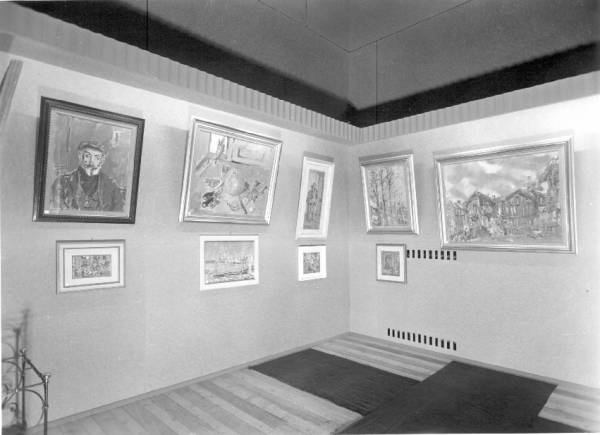
1946: On July 29, de Pisis recommended Music to Rimoldi: «Dear Friend, I introduce you to the painter Music. He deserves to be supported. Please, purchase some of his works for your collection. I am sure they will continue to increase in value. He recently received an award at the “Colomba” international art contest and I have written a monograph on him, which I will show you».
1948: A London gallery offered Rimoldi 60 million Lire to purchase a group of de Pisis’s paintings (interview with Fiorello Zangrando). He would receive similar offers from New York, and even from Moscow.
1949: Rimoldi supported the creation of the Premio “Cortina-Ulisse”, on behalf of Maria Luisa Astaldi, to be awarded to a work of scientific knowledge dissemination «in the belief that culture should be a common good for all humanity and not an asset or legacy of the privileged few». Mario Rimoldi was always convinced that Cortina had to distinguish itself with a high-level prize similar to the Viareggio or Strega awards. During the ceremonies he would «always be present, be listened to, and followed» (Renato Giani).
1950: Rimoldi was one of the founders of the Circolo Artistico di Cortina d’Ampezzo. The art club was officially opened in Palazzo Ariston, on August 5. [The seasonal activity of the Club featured a wealth of first class events, namely, conferences, exhibitions, concerts…] For the event, an “Exhibition on Contemporary Painting from Galleria Rimoldi” (about 70 works) was held with a presentation by Rodolfo Pallucchini. On August 20, the idea of the Premio Parigi was born. From the minutes of the first meeting: «On this day, 20th August, 1950 at 3.00 p.m. painter Massimo Campigli, Prof. Luigi Ferrarino, Mr. Mario Rimoldi, painter Mino Rosi, painter Mario Sironi got together in Cortina d’Ampezzo to discuss the creation of a Prize for Painting and Sculpture, to be awarded every two years in Cortina d’Ampezzo and to be named ’Premio Parigi’. The proposal was put forward by Prof. Luigi Ferrarino as director of the Italian Institute of Culture in Paris. Such a prize, which was to be offered by the Italian Embassy, consisted in the organization of a personal painting or sculpture exhibition which the winners would hold in one of the major art galleries in Paris during the Autumn-Winter of 1951; a monographic Catalogue on the winning artists; and a stay in Paris (travel included) of said winners for one month. The Italian Embassy in France committed themselves to forming the selection board, made up of illustrious French painters, sculptors and art critics who would go to Cortina d’Ampezzo for a week in order to select and announce the winners. Collector Mario Rimoldi was appointed president of the Organizing Committee. He participated in this initiative and immediately acted, by creating an additional Purchase Prize called “Premio Rimoldi”, and promoted the creation of additional prizes awarded by the local and provincial authorities». In November, Rimoldi – who owned more than one thousand works by then – married Rosa Braun from Bolzano who would become his loyal and discrete companion until his death. There are two very beautiful portraits of Rosa Braun made by Campigli and by Sironi. Rimoldi would leave her a substantial part of his collection and all his art books. It was Rosa Braun who generously donated more than 170 works by 87 artists to the Regole d’Ampezzo. This donation included graphic works and sculptures, Rimoldi’s personal library, and some precious documents (published and unpublished). This made the creation of the “Mario Rimoldi'' Modern Art Gallery possible. The gallery was officially opened in August 1974. Thus, one of Rimoldi’s most coveted dream projects was achieved. In December, Rimoldi organized an exhibition of Sironi’s paintings; unfortunately, he did not inform the painter on time. Sironi wrote to him, manifesting his regret: «Dear Rimoldi, I have received Cortina local newspaper with the news of my exhibition, but I have never heard a word from you about it – and that would have been greatly appreciated. Apparently, you were too busy to remember an old friend and all his troubles! [...] I am so sad I cannot come to Cortina and aware that I am now far away and shut out from that world I have loved so much! To you, my dear Rimoldi, and your family, I’m sending my greetings and expressing the wish to be remembered even though my hard fate has me handcuffed! I cannot believe that you forgot me! It is too sad». The exhibition was opened on 1st December by Minister of Justice Attilio Piccioni and was then moved to Paris and London.
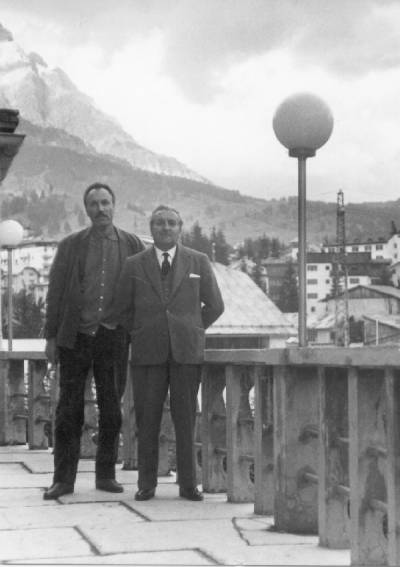
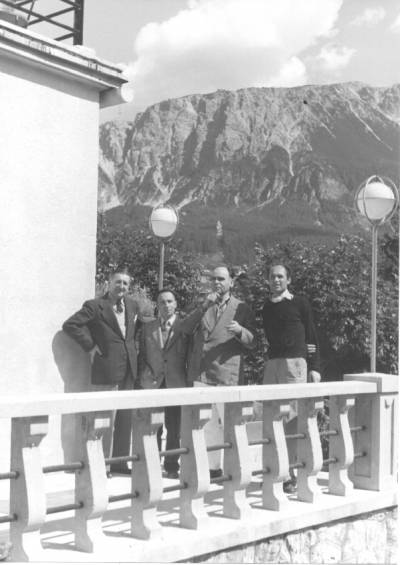
1951: Rimoldi was elected mayor of Cortina d’Ampezzo and held this position until 1956. He had entered public life while still very young. He had been Member of the Tourist Promotion Committee in Cortina, Member of the Tourist Promotion (E.P.T) Board, Chairman of the “Unione Gente Italica” (Union of Italian Peoples), Chairman of the “Corpo Musicale di Cortina” (Cortina’s Band), Founder of the “Circolo Artistico e Culturale” (Art Club) of Cortina, Director of the Industrial Art School, Honorary Supervisor of Monuments and Excavations for the Ampezzo, Cadore, Comelico, Zoldano regions, etc. On January 8, Rimoldi, together with the Tourist Promotion Committee, proposed that the Circolo Artistico, considering the intense cultural activity of the art club, become Ente Culturale Cortinese under the aegis of the Municipality and the tourist bodies. On Saturday July 28, before the representatives of the French and Italian governments, the National Art Exhibition “Premio Parigi, 1951” was initiated in the building of the former “Duca d’Aosta” school. Mario Rimoldi chaired the Executive Committee. The works on display (a hundred paintings and some thirty sculptures) were selected by an Italian committee formed by Massimo Campigli, Raffaele Carrieri, Felice Casorati, Virgilio Guzzi, Marino Marini, Rodolfo Pallucchini, Gino Severini, Mario Sironi, and Mino Rosi, the secretary. A French committee formed by Marcel Arland, Jean Bouret, André Chastel, Frank Elgar, Fernand Léger, Jacques Villon, Ossip Zadkine (Léger did not actively participate) judged the works on exhibit. The “Premio Parigi” for painting was awarded to Antonio Corpora and Zoran Music (recommended by Giuseppe Santomaso, Luigi Spazzapan, and Renato Birolli), the “Premio Parigi” for sculpture was given to Marcello Mascherini (recommended by Franchina, Giuditta Scalini, and Aldo Calò). Carlo Sergio Signori received an honorary prize. Zoran Music also owed his European triumph to the success of his exhibitions at the Galerie de France in Paris.
Rimoldi advocated the creation of the “Editore Cappelli”, Bologna, literary prize to be awarded to a book dealing with mountain themes. On 9th August, at the Circolo Artistico, the first prize was awarded to Spiro della Porta Xidias for the book I bruti della Val Rosandra and the second prize went to Giuseppe Degregorio for Cortina e le sue montagne. A catalogue on the works belonging to the Rimoldi collection, on display at Hotel Corona, was made.
1952: Rimoldi organized an exhibition on Mario Sironi in January and one on Giorgio de Chirico in December [both exhibitions were staged at the Circolo Artistico].
1953: de Chirico came to Cortina for Christmas; he made some drawings and wrote the poem Christmas about Cortina.
1954: Rimoldi started to commit himself body and soul to the organization of the 7th Winter Olympics. For his commitment, he received a distinction award by the Italian Republic (May 24). On 18th August, during a members meeting of the Circolo Artistico, Rimoldi, as mayor of Cortina, promised that he would do all he possibly could to ensure the survival of the Circolo, confirming the commitment of the Municipality to offer the Circolo more suitable headquarters in the new building that was being erected by the municipality in co-ownership with the Ministry of Post and Telecommunications (from the minutes of members meeting in «Il Circolo Artistico di Cortina d’Ampezzo» di Remo Da Col).
1955: The municipality of Cortina provided the Circolo Artistico with new offices, just before the start of the Olympics. Rimoldi purchased Guttuso’s famous painting, The Sulphur Mines, at the Rome Quadriennale. This painting was then lent out to Leningrad, for a personal exhibition on Guttuso, where it remained on display at the Hermitage for several months. Rimoldi refused an offer of thirty millions from that Museum for the purchase of the painting.
1956: The 7th Winter Olympics marked a memorable moment in the history of Cortina. Rimoldi received many acknowledgements for what he had done for Cortina and Italy. On 30th August a presidential decree allowed him to bear the title of Commendatore dell’Ordine Equestre di Sant’Agata, bestowed upon him by the Consiglio grande e generale of the Serenissima Repubblica di San Marino. The decree was dated 15th March, 1956: «in honour and recognition of the merits acquired in the organization of the Seventh Olympic Games in Cortina». Rimoldi saw to it that sculptor Claudio Trevi realized the large bas-relief decorating the Post and Telecommunications building, designed and built by architect Edoardo Gellner. Rimoldi organized a large-scale retrospective exhibition on de Pisis in the hall of the Circolo Artistico [from August 10 to 31]. This exhibition was meant as a grateful tribute, as Rimoldi’s acknowledgement of the artist and friend who had recently died. It comprised 60 works selected from the three hundred works in the Rimoldi collection, many of which had been created in Cortina.
1957: Rimoldi continued to receive special acknowledgements for his work. On June 13, Bruno Zauli, Secretary General of the Italian National Olympic Committee (CONI), informed the mayor of Cortina and the Prefetto (provincial governor) in Belluno by letter that «on the occasion of Evian’s international meeting, the Executive Committee of the Olympic International Committee renewed their most deeply felt praises to the CONI delegation for the excellent success of the Seventh Winter Olympic Games that had taken place in Cortina d’Ampezzo in 1956» and expressed their most sincere appreciation for the efficient cooperation given by the local Administration presided by Rimoldi. Aldo Moro, Minister of Public Education, sent him a telegram on 22nd August: «Pleased to inform, conferring silver medal for merits school culture and art approved by President of Republic, on my proposal. Heart-felt congratulations and best regards».
1961: The collector organized an exhibition dedicated to Sironi at the Circolo Artistico (6th August-15th September) displaying works belonging to Rimoldi, Antonio Allaria, and other private collectors.
1962: Rimoldi returned to Galleria Zamberlan in Venice where he had purchased his first paintings. The catalogue included a personal exhibition of Renato Balsamo. A first inventory of the works owned by Rimoldi was set up.
1964: Together with Rosa Braun and Renato Balsamo, Rimoldi met de Chirico in Rome for the certification of some twenty of de Chirico’s paintings. During the meal, de Chirico wrote a poem dedicated to Rosa Braun.
1965: An exhibition on Cesetti was organized [at the Circolo Artistico] with all the works owned by Rimoldi. Back in Cortina after many years of absence, Cesetti personally opened the exhibition.
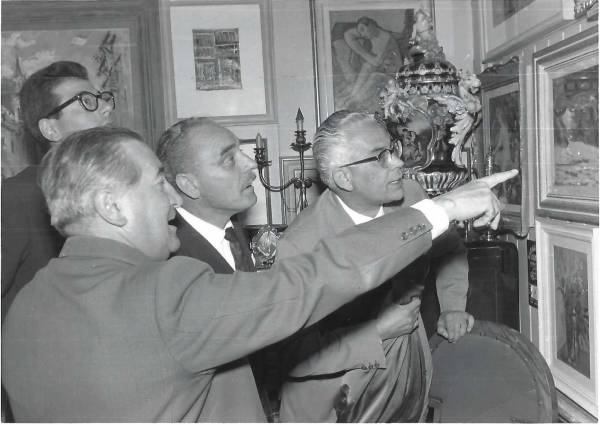
1966: Neri Pozza addressed the then Minister of Public Education Mariano Rumor to ensure that the Rimoldi collection be housed in an appropriate place in Cortina. What was basically asked for was the construction of «a place that is multifunctional – a museum, library and meeting place, a venue for cultural meetings, a theatre, and a concert hall». This was to be funded by the Ministry of Public Education and, in part, by the Casse di Risparmio Venete.
1967: The “Annunciata” Art Centre in Milan asked Rimoldi for the photographic reproductions of all the Carrà paintings he owned in order to include them in the general catalogue on the workscreated by the Master. Guido Cadorin wrote to Rimoldi on 11th August and sent him an article by J. Bouret at the end of his anthological exhibition in Venice. He seized the opportunity to dutifully state: «You have been the first of the great collectors to purchase and promote my work and it is therefore right that I express my extreme gratitude to you for this».
1968: Paolo Rizzi published an article - Modigliani in the Nook - on page 3 of the “Gazzettino” newspaper of October 3rd in which he asked: «Wouldn’t it be right to honour this great collector by holding an exhibition? ». Subsequently, Paolo Rizzi tried to realize this project, which he had already mentioned to Rimoldi during the summer. The project was to be «an exhibition of his collection in Venice, dedicated to de Pisis paintings, to be organized (most probably around Christmas time) by the Municipality at Ca’ Vendramin Calergi, in the Wagner rooms, with the financial support of the Casinò Municipale». The Rimoldi collection was included, under the heading “Collectors”, in the International Yearbook of Fine Arts edited in Western Berlin.
1969: On July 12, an important exhibition “Mostra dell’opera pittorica e grafica di Filippo de Pisis” was opened at Palazzo della Gran Guardia in Verona (6th July-21st September). There were four paintings belonging to Rimoldi: Le armature del Poldi Pezzoli, Viva Rimoldi, Paesaggio, and La pastorale.
1972: Rimoldi died in Cortina d’Ampezzo on 23rd July. [The representatives of the Municipality and of the Tourist Board, celebrities of the world of culture, school, and sports and several artist friends were present at the farewell ceremony].